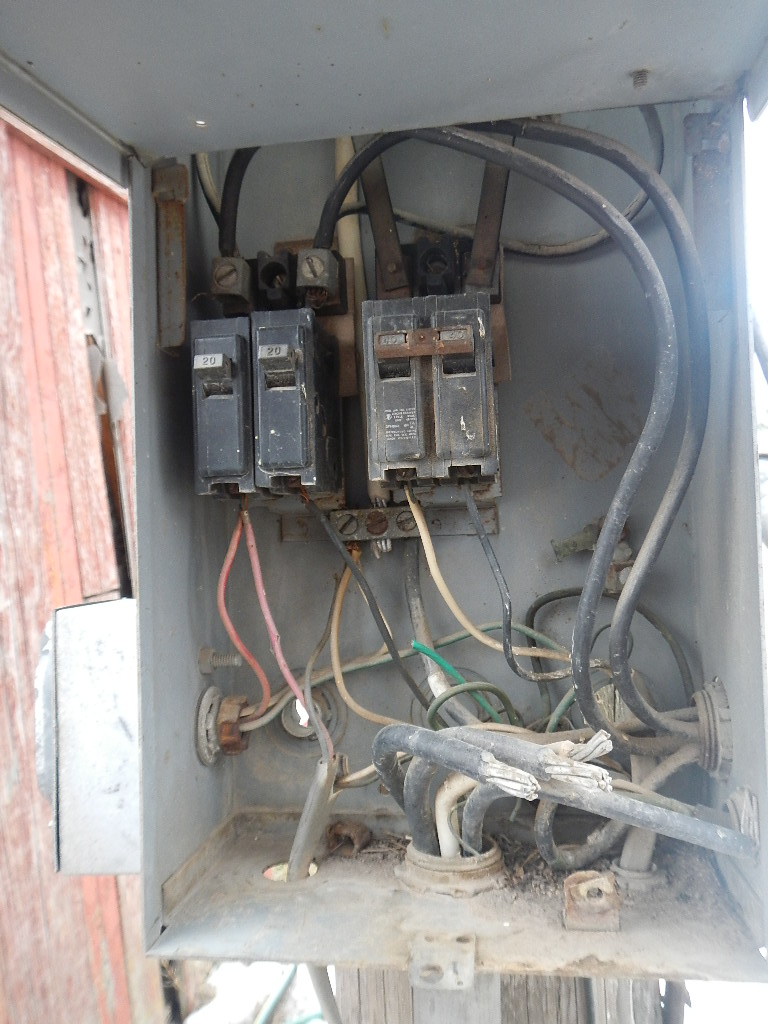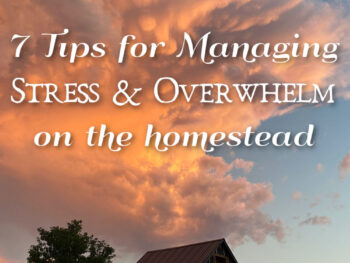Photovoltaics, or solar panels, are one of the most popular options for folks interested in utilizing renewable energy sources at home. Compared to wind turbines, solar panels are a more productive source of alternative energy for the average home. Why? Because they rely on sun exposure and not a strong, steady wind to produce power. Even here in Montana where we have cloudy, gray winter days there is still enough light for solar panels to produce energy.
Installing solar panels at home is not as easy as slapping some panels up on your roof. How do I know this? My husband used to be co-owner of a solar business in town. He’s given me an earful on alternative energy and photovoltaic systems that I’m going to share with you today.
Our Photovoltaic System
At our old house we had a 4 panel photovoltaic (PV) system on our roof. When we installed them a couple years ago, I remember sitting inside nursing our newborn baby while the guys were out working on the roof installing the panels. There was a lot of banging around for a few hours but at the end of the day the solar panels were in place. They called in the inspection with the county for approval to hook it up to our house’s electrical system. As soon as we got the inspector’s ok, we were live!
When we moved to our new homestead this summer, I assumed that it would be a quick and easy one day project to put solar panels in at our new house. Our whole handmade business, MontanaSolarCreations, revolves around using solar power for crafting the creations we sell in our Etsy shop. Considering this, I felt a sense of urgency about needing to get a PV system up and running at our new house as soon as possible.
In the fall, I updated our Etsy shop announcement to note that temporarily our made to order items were not made with solar power. When I wrote that, I figured it would be up there for less than a month. Well, here we are four months later and it is still up there.
Is Your Home Ready for Photovoltaics?
Why don’t we have a PV system installed yet? Well let me tell you, it is a lot more complicated than what I ever imagined. When planning to install solar panels at your home, you need to take a few things into consideration to see if your house is even ready for solar panels. These are things like:
- Does part of your roof face south with no obstructions like trees to block the sun?
- If you do not have a south facing roof, do you have a location on your property for a solar panel array mounted to a pole in the ground?
- Is your roof structurally stable to withstand the weight of photovoltaics mounted to it?
- What is your roof pitch? Is it steep enough to prevent snow from laying on the panels?
- Is your house’s electrical system up to date?
- What are the electrical, roofing and building codes in your area?
- Do you have the funds to pay for solar panels? Do you qualify for any grants or state/federal tax credits to offset the cost?
Our Current Delay in Installing a Photovoltaic System
Does the roof of our new house face south? Yes it does BUT it is an old ranch style house with a shallow roof pitch. This means that we would end up not maximizing the benefit of our solar panels during the winter because they would be covered in snow. We also have a large tree on the west side of our house that would block some of the sun’s rays for a few hours of the day.
Do we have another south facing location on our property where we can put up photovoltaics on a pole? Yup we do, we have the perfect spot right behind the shop. My husband even said that since the solar panels would be on a pole it would give him the ability to move the array slightly throughout the year to follow the direction of the sun. This would allow us to maximize the amount of solar energy we could get with our panels.
Is our house’s electrical system up to date? This is a big, fat NO! Unfortunately this is the big hang up in why we still do not have solar panels at our new house. Before we signed on the dotted line and became the new owners of our bank owned fixer upper, we knew there was some major work that needed to be done. I didn’t fully understand what that meant for our photovoltaics installation until I really started pressing my husband to get the new solar panels installed at our house.
First off, our whole electrical system at our home needs to be upgraded. The old decrepit meter base is attached to a leaning power pole that one day just may topple over in a wind storm. If that doesn’t inspire a person to get it moved I don’t know what will! Luckily there is a new power pole right next to it just waiting to be the host to a new, lovely, upgraded meter base. Just look at this thing!
Replacing the meter base may not sound like that big of an ordeal so you’re probably wondering what the hold up is. Well, that is just the tip of the iceberg! You see, the shop and the house power all run through that same trusty meter base that needs to be replaced. The power that runs from the meter base to the shop runs underground but the former owner did not put it in conduit. This means the wires, which are not rated to be buried, are under the ground exposed to the elements. Which means that you can see this bundle of wires simply wrapped in black electrical tape running from the shop into the ground.
Those are wires that carry some pretty hefty electrical power to the shop, 200 amps is what I’m told. I interpret it as a big, hefty, body frying shock. Sketchy isn’t it?
This basically means that we have a much bigger project on our hands before we can ever install our beloved solar panels. It means that we will have to dig a trench (with the power turned off of course!) from the shop to the new meter base. We will then have to re-run new wires in a proper conduit that is approved to be buried.
Now that you understand just how big of a project we are facing, are you wondering why we haven’t started working on it? Well, it is now winter in Montana. Which means the ground is frozen. Yup, we’re in for the long haul now. We won’t be able to embark on our project until spring when the ground starts to thaw.
Now that we know what our photovoltaics project entails, the other big question is: how expensive will it be? We’ll be penciling it out and crunching numbers this winter to see if we can even afford to do this solar panel project all at once in the spring. We’ll be sharing more posts about our photovoltaics project so you can see our progress and one day we’ll eventually get them installed!
This post shared on: The Down Home Blog Hop, Mountain Woman Rendezvous, HomeAcre Hop, Frugal Days Sustainable Ways,Small Footprint Fridays, From the Farm Blog Hop, Simple Saturdays, Natural Living Monday, Homestead Barn Hop, Tuesday Greens, Backyard Farming Connection,















Great tips! Solar panels are a long term goal of ours. We live along the Tx Gulf Coast so we have plenty of sun and no snow….
I used to live on the gulf coast in TX and miss all the sunshine we had year round! When you do install solar panels, I bet you will produce an amazing amount of power with all the sun you get!
Thanks for sharing on Backyard Farming Connection. We already have photovoltaics, as our front roof faces perfectly south, with no obstructions. It was an expensive endeavor, but probably the most environmentally friendly thing we’ve done. Great to educate others about it, so thanks for posting.
That’s wonderful that you already have photovoltaics and your roof sounds like the perfect spot! It really is an expensive endeavor but I just keep reminding myself that it will eventually pay off some day!
That’s great to hear you dealt with your old wiring and are getting ready for solar panels! We were lucky our house didn’t have to be completely rewired on top of all the electrical upgrades we need to do outdoors. I will definitely check out your blog and look forward to reading about your solar panel project!
I have been thinking about this also, but I have a question. How far away can the panels be from the charge controller and batteries?
Can I put up a shed and store my batteries and charge controller in there? Now one thing I think I should add is I live in Minnesota so in the winter it could get down to -20 in the shed and in the summer it could get kind of warm? The reason I ask is a friend of mine said that the farther you transmit DC power the more power you lose.
Any thoughts would be appreciated.
Hi Jim! I’m Walter, Annie’s husband. Your friend is correct, you will experience voltage drop running long distances. You should try to place your CC and batteries as close as possible to the panels.
Batteries can be placed outside, but should be in stored in an insulated box. Flooded batteries can withstand freezing down to -40f at full charge. At 50% charge down to about zero F. AGM batteries are more resistant to freezing but come with a higher price tag.
If you are serious about adding solar to your property, working with a qualified PV specialist is the best thing I can recommend. There are too many variables.
Thanks for the feed back!
One question I forgot to ask yesterday. Someone told me that charging batteries can give off Hydrogen, is this true also? Is it save to have those batteries in our basement, or is it better to have them in an outside location?
Flooded Lead Acid batteries will off gas and produce hydrogen. They can be installed indoors (recommended) in a battery box with a 2″ pvc pipe near the top of the box vented to the outside.
I hope you can get your issues resolved soon! We want to put solar panels on our next house, in about 5 years. I’d like to do it here, but we know that it would be one more expense that we would not get back when we sell. 🙁
Thanks for sharing on The HomeAcre Hop! Hope to see you again today! We have a brand new giveaway going on…be sure to enter for a chance to win!
http://www.theselfsufficienthomeacre.com/2014/01/anniversary-giveaway-week-2-the-homeacre-hop-55.html
Lisa-
Something to ponder. Homes with solar sell 20% faster than similar homes on the market. If your area is flooded with homes for sale this could make your home standout over the competition. Also, for every dollar saved with solar it ads $20 to the value of your home. So if solar saved you $100 over the course of the year it would add $2000 to the value of the home. Lastly, solar is essentially an appliance, you could take the system with you when you moved.
Can you still have knob and tube wiring and get solar panels installed. And will home insurance need to be upgraded after installation of Solar panels inspite of the existing knob and tubing wiring system?
I’m not an electrician so I apologize but I cannot answer your questions. I would suggest finding a local solar installer in your area who could hopefully help you answer your questions. Good luck!